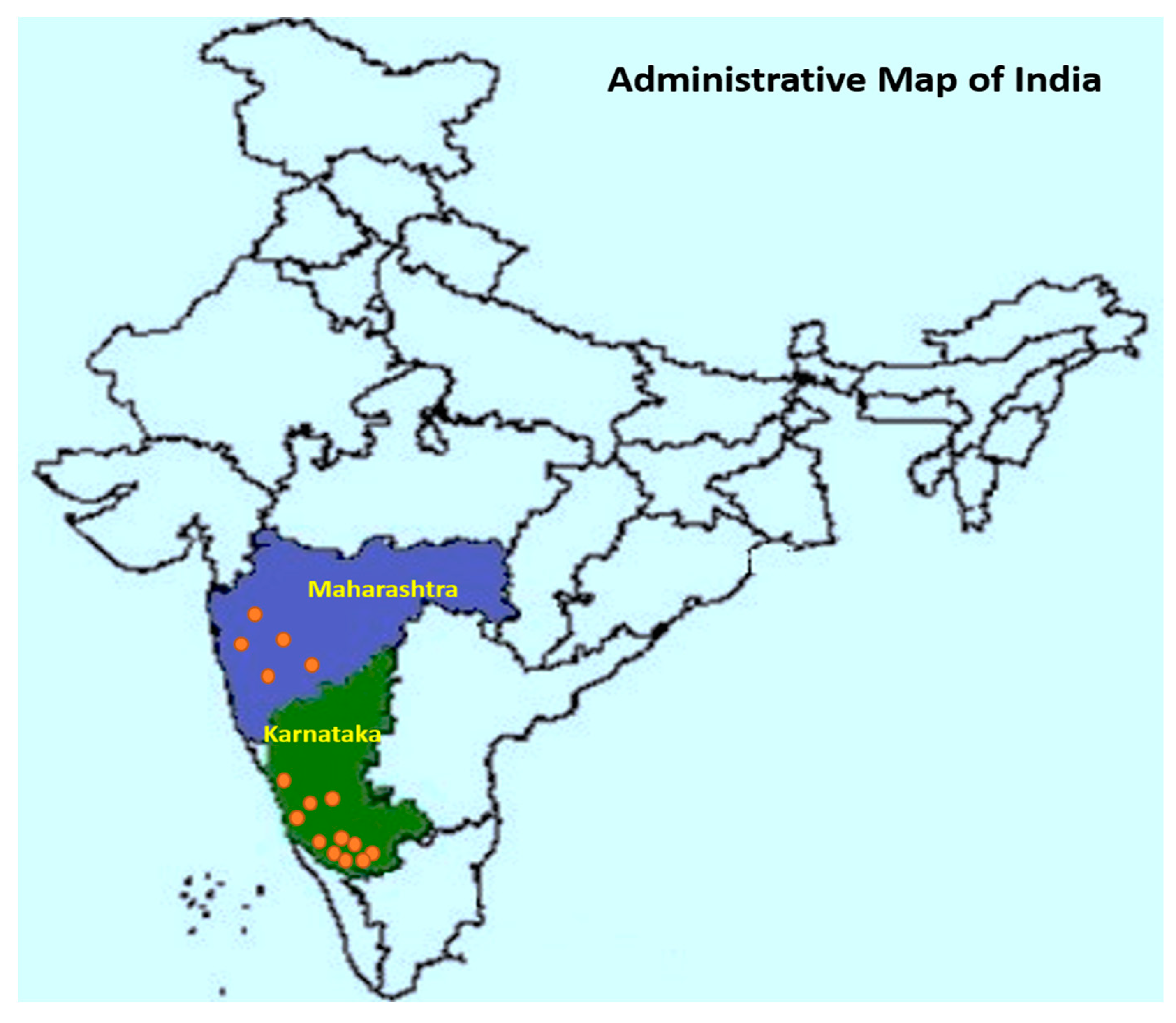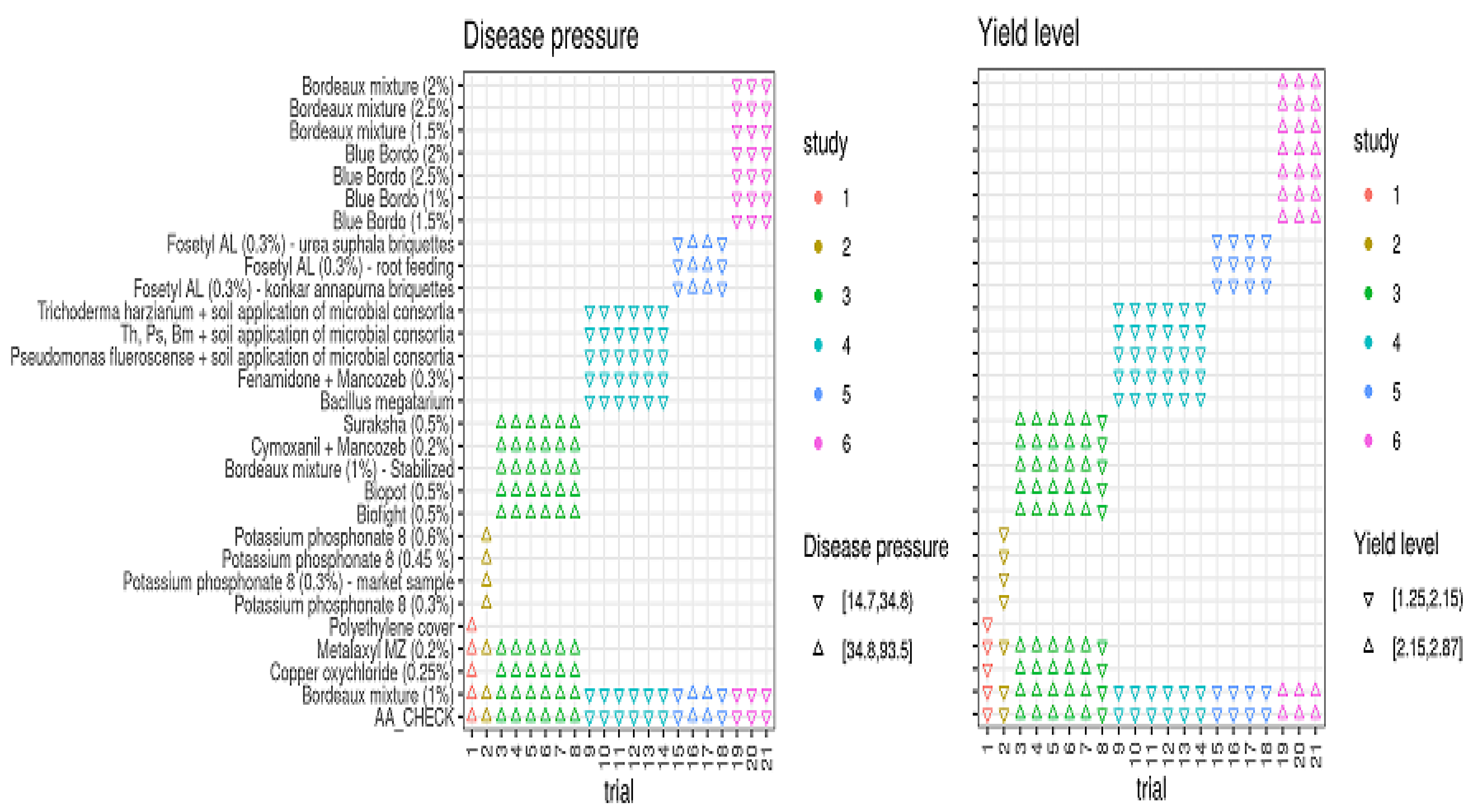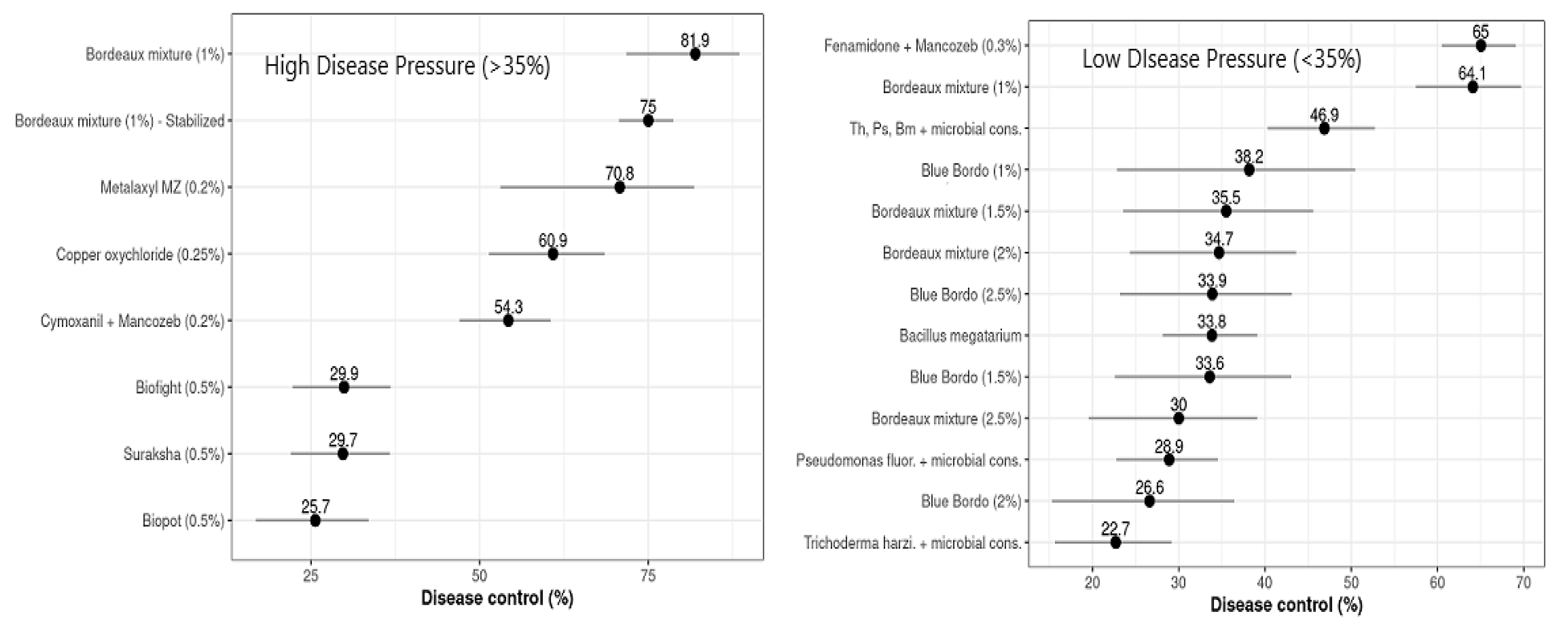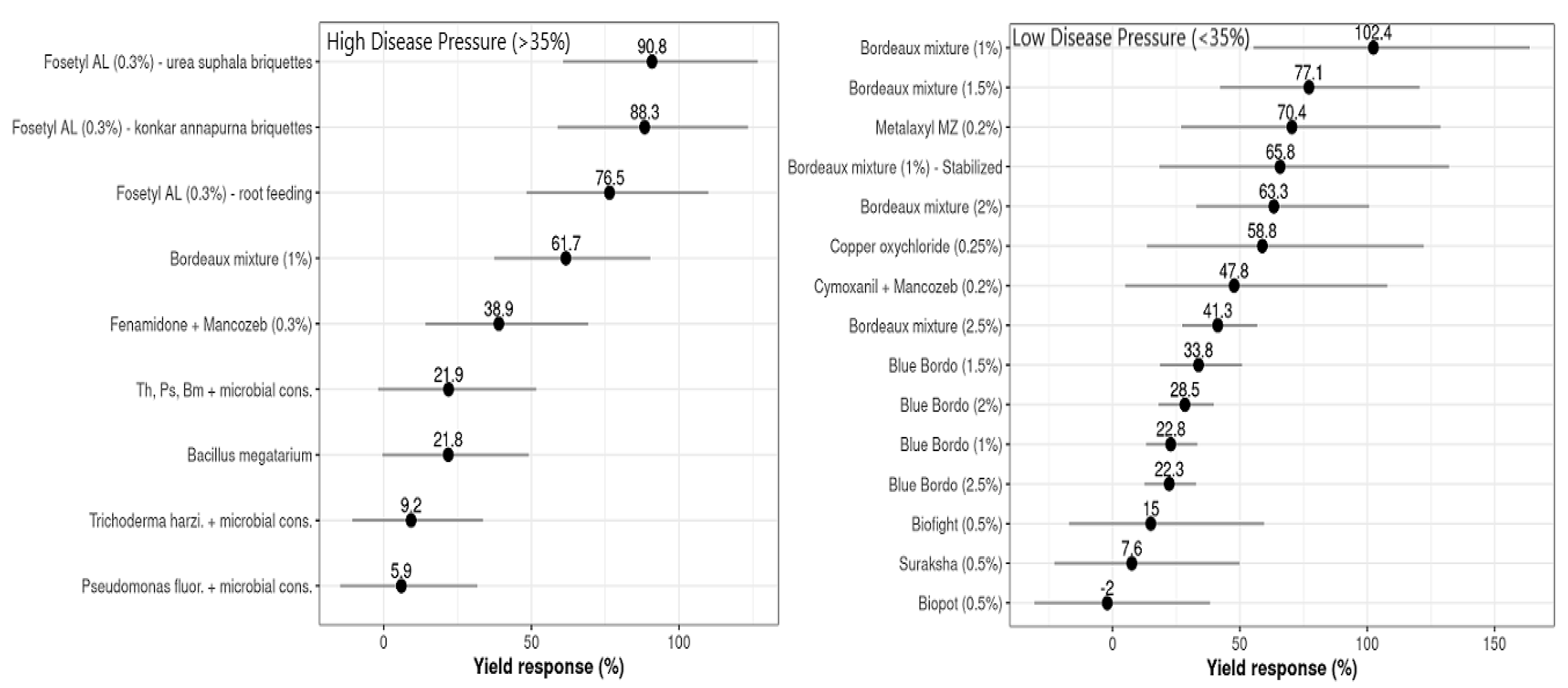Control Efficiency and Yield Response of Chemical and Biological Treatments against Fruit Rot of Arecanut: A Network Meta-Analysis
Abstract
1. Introduction
2. Materials and Methods
2.1. Dataset, Experimental Design, and Application
2.2. Meta-Analytical Synthesis and Effect Size
2.3. Disease Control Analysis
2.4. Yield Response Analysis
2.5. Quantitative Data Synthesis
3. Results
3.1. Epidemics and Yields in Treated/Control Plots
3.2. Meta-Analysis of Disease Control Efficiency
3.2.1. High Disease Pressure (DPHigh > 35%)
3.2.2. Low Disease Pressure (DPLow ≤ 35%)
3.3. Meta-Analysis of Yield Response or Gain
3.3.1. Lower Yield Level (DPHigh > 35%)
3.3.2. Higher Yield Level (DPLow ≤ 35%)
3.4. Effects of Moderator Variables on Yield Responses to Treatments
4. Discussion
5. Conclusions
Author Contributions
Funding
Institutional Review Board Statement
Informed Consent Statement
Data Availability Statement
Acknowledgments
Conflicts of Interest
References
- Sastry, M.N.L.; Hedge, R.K. Taxonomic identity of arecanut Phytophthora isolates from the gardens of Sirsi, Uttara Kannada. In Arecanut Research and Development; Shama Bhat, K., Radhakrishnan Nair, C.P., Eds.; Central Plantation Crops Research Institute: Kasaragod, India, 1985; pp. 92–94. [Google Scholar]
- Balanagouda, P.; Vinayaka, H.; Maheswarappa, H.P.; Narayanaswamy, H. Phytophthora diseases of arecanut in India: Prior findings, present status and future prospects. Indian Phytopathol. 2021, 74, 561–572. [Google Scholar] [CrossRef]
- Saraswathy, N. Diseases and Disorders; Rajagopal, V., Balasimha, D., Eds.; Arecanut, Central Plantation Crops Research Institute: Kasaragod, India, 2004; pp. 134–169. [Google Scholar]
- Butler, E.J. Some diseases of palm. Agric. J. Indian 1906, 1, 299–310. [Google Scholar]
- Coleman, L.C. Diseases of the Areca Palm. In Koleroga; Mycological Series; Bulletin No. 2; Department of Agriculture: Bangalore, India, 1910. [Google Scholar]
- Dutta, P.K.; Hegde, R.K. Studies on two Phytophthora diseases (Koleroga of arecanut and black pepper wilt) in Shimoga district, Karnataka State. Plant Pathol. 1987, 5, 12–29. [Google Scholar]
- Jose, C.T.; Balasimha, D.; Kannan, C. Yield loss due to fruit rot (Mahali) disease of arecanut in Karnataka. Indian J. Arecanut Spices Med. Plants 2008, 10, 45–51. [Google Scholar]
- Santhakumari, P.; Hegde, R.K. Studies on Phytophthora diseases of plantation crops. Plant Pathol. 1987, 5, 28. [Google Scholar]
- Saraswathy, N. Studies on Phytophthora spp. on Arecanut and Arecanut Based Cropping Systems. Ph.D. Thesis, Mangalore University, Mangalore, Karnataka, 1994. [Google Scholar]
- Sarma, Y.R.; Chowdappa, P.; Anandaraj, M. IPM System in Agriculture: Key Pathogens and Diseases; Adithya Books Pvt. Ltd.: New Delhi, India, 2002. [Google Scholar]
- Saraswathy, N. Symptomatology of Phytophthora diseases of areca palm. In Disease Detection in Horticultural Crops; Central Plantation Crops Research Institute: Kasaragod, India, 2003; pp. 12–14. [Google Scholar]
- Marudarajan, D. The use of plain Bordeaux mixture for the successful control of fruit rot (Mahali] of arecanut caused by Phytophthora arecae. Madras Agric. J. 1950, 35, 169–178. [Google Scholar]
- Sundararaman, S.; Ramakrishnan, T.S. The mahali disease of coconut in malabar. Meml. Dept. Agric. India 1928, 13, 87–97. [Google Scholar]
- Waterhouse, G.M. Phytophthora Palmivora and Some Related Species. In Phytophthora Diseases of Cocoa; Tall, G., Ed.; Longman: London, UK, 1974; pp. 51–70. [Google Scholar]
- Balanagouda, P.; Sridhara, S.; Shil, S.; Vinayaka, H.; Naik, M.K.; Narayanaswamy, H.; Siva, K.B. Assessment of the spatial distribution and risk associated with fruit rot disease in Areca catechu L. J. Fungi. 2021, 7, 797. [Google Scholar] [CrossRef]
- Chowdappa, P.; Saraswathy, N.; Venugopal, K.; Somala, M. Annual Report; Central Plantation Crops Research Institute: Kerala, India, 2000; p. 69. [Google Scholar]
- Chowdappa, P.; Saraswathy, N.; Vinayagopal, K.; Somala, M. Natural occurrence of Phytophthora heveae. Indian Phytopathol. 2002, 55, 366. [Google Scholar]
- Lokesh, M.S.; Patil, S.V.; Palakshappa, M.G.; Gurumurthy, S.B. Role of systemic fungicide metalaxyl mancozeb in management of Koleroga (Phytophthora meadii McRae) of arecanut (Areca catechu L.) in Central Western Ghats of Karnataka. Asian J. Biol. Sci. 2014, 9, 131–133. [Google Scholar]
- Hegde, G.M. Bio-efficacy of potassium phosphonate against nut rot disease of areca nut (Areca catechu L.) in the northern Karnataka of India. Sri Lanka J. Food. Agri. 2015, 1, 9–14. [Google Scholar] [CrossRef][Green Version]
- Pande, V.S.; Dademal, A.A.; Kasture, M.C.; Bhagwat, R.G. Management of Koleroga of arecanut caused by application of fungicide amended fertilizer briquettes Phytophthora meadii. J. Indian Soc. Coastal Agric. Res. 2016, 34, 88–90. [Google Scholar]
- Narayanaswamy, H.; Raju, J.; Jayalakshmi, K. Management of fruit rot disease of arecanut incited by Phytophthora meadii. Int. J. Curr. Microbiol. Appl. Sci. 2017, 6, 2824–2828. [Google Scholar] [CrossRef]
- Gangadhara Naik, B.; Maheshwarappa, H.P.; Nagamma, G.; Latha, S. Management of fruit rot disease of arecanut (Areca catechu L.) caused by (Phytophthora meadii McRae.). Int. J. Curr. Microbiol. Appl. Sci. 2019, 8, 837–847. [Google Scholar] [CrossRef]
- Ravikumar, M.; Pradeep Kumar, B.A.; Niranjana, K.S. Standardization of concentration of Bordeaux mixture for management of fruit rot disease (P. meadii) of arecanut. Green Farming 2019, 10, 115–117. [Google Scholar]
- Paul, P.A.; Lipps, P.E.; Hershman, D.E.; McMullen, M.P.; Draper, M.; Madden, L.V. Efficacy of triazole-based fungicides for Fusarium head blight and deoxynivalenol control in wheat: A multivariate meta-analysis. Phytopathology 2008, 98, 999–1011. [Google Scholar] [CrossRef]
- Machado, F.J.; Santana, F.M.; Lau, D.; Del Ponte, E.M. Quantitative review of the effects of triazole and benzimidazole fungicides on Fusarium head blight and wheat yield in Brazil. Plant Dis. 2017, 101, 1633–1641. [Google Scholar] [CrossRef]
- Edwards-Molina, J.P.; Paul, P.A.; Amorim, L.; da Silva, L.H.C.P.; Siqueri, F.V.; Borges, E.P.; Campos, H.D.; Nunes, J., Jr.; Meyeri, M.C.; Martins, M.C.; et al. Meta-analysis of fungicide efficacy on soybean target spot and cost–benefit assessment. Plant Pathol. 2019, 68, 94–106. [Google Scholar] [CrossRef]
- Paul, P.A.; Madden, L.V.; Bradley, C.A.; Robertson, A.E.; Munkvold, G.P.; Shaner, G. Meta-analysis of yield response of hybrid field corn to foliar fungicides in the U.S. Corn belt. Phytopathology 2011, 101, 1122–1132. [Google Scholar] [CrossRef]
- Borenstein, M.; Hedges, L.V.; Higgins, J.P.T.; Rothstein, H.R. Introduction to Meta-Analysis; John Wiley & Sons: Chichester, UK, 2009. [Google Scholar]
- Madden, L.V.; Piepho, H.P.; Paul, P.A. Statistical models and methods for network meta-analysis. Phytopathology 2016, 106, 792–806. [Google Scholar] [CrossRef]
- Paul, P.A.; McMullen, M.P.; Hershman, D.E.; Madden, L.V. Meta-analysis of the effects of triazole-based fungicides on wheat yield and test weight as influenced by Fusarium head blight intensity. Phytopathology 2010, 100, 160–171. [Google Scholar] [CrossRef] [PubMed]
- Tedford, E.; Kriss, A.; Geater, C.; Saini, M.; Battles, B.; Smelser, R. Plot size can influence yield benefits from fungicides on corn. Crop Prot. 2017, 91, 66–73. [Google Scholar] [CrossRef]
- Madden, L.V.; Paul, P.A. Meta-Analysis for Evidence Synthesis in Plant Pathology: An Overview. Phytopathology 2011, 101, 16–30. [Google Scholar] [CrossRef] [PubMed]
- Kandel, Y.R.; McCarville, M.T.; Adee, E.A.; Bond, J.P.; Chilvers, M.I.; Conley, S.P. Benefits of Fluopyram addition to the base seed treatment for suppressing sudden death syndrome and increasing soybean yield: A meta-analysis. Plant Dis. 2018, 102, 1093–1100. [Google Scholar] [CrossRef] [PubMed]
- Borenstein, M.; Hedges, L.V.; Higgins, J.P.T.; Rothstein, H.R. A basic introduction to fixed-effect and random-effects models for meta-analysis. Res. Synth. Methods. 2010, 1, 97–111. [Google Scholar] [CrossRef]
- Higgins, J.P.T.; Jackson, D.; Barrett, J.K.; Lu, G.; Ades, A.E.; White, I.R. Consistency and inconsistency in network meta-analysis: Concepts and models for multi-arm studies. Res. Synth. Methods 2012, 3, 98–110. [Google Scholar] [CrossRef]
- Viechtbauer, W. Conducting meta-analyses in R with the METAFOR package. J. Stat. Soft 2010, 36, 1–48. [Google Scholar] [CrossRef]
- Tupich, F.L.B.; Fantin, L.H.; Silva, A.L.; Canteri, M.G. Impacto do controle do mofo-branco com fluazinam na produtividade da soja no Sul do Paraná: Metanálise. Summa Phytopathol. 2017, 43, 145–150. [Google Scholar] [CrossRef][Green Version]
- Ploper, L.D.; Gonzalez, V.; Lisi, V.D.E.; Reznikov, S.; Henriquez, D.D.; Devani, M.R. Research on Target Spot of Soybean in NorthWestern Argentina; WSRC IX: Durban, South Africa, 2013. [Google Scholar]
- Belufi, L.; Kempim, F.; Pasqualli, R. Avaliacao da Eficiencia de Fungicidas Aplicados no Vegetativo Para o Controle de Mancha Alvo (Corynespora cassiicola) na Cultura de Soja no Mato Grosso. Lucas do Rio Verde, Mato Grosso. 2015. Available online: http://www.fundacaorioverde.com.br/publicacoes/88 (accessed on 23 March 2022).
- Hegde, V.M.; Sharadraj, K.M.; Prathibha, V.H. Colocasia: Alternative Host for Arecanut Pathogen Phytophthora Meadii. PLACROSYM 22: 22nd Biennial Symposium on Plantation Crops. Available online: http://14.139.158.120:8000/xmlui/bitstream/handle/123456789/7357/PLACROSYM%2022%20Abstract%20final.pdf?sequence=1 (accessed on 23 March 2022).
- Willbur, J.F.; Fall, M.L.; Bloomingdale, C.; Byrne, A.M.; Chapman, S.A.; Isard, S.A.; Magarey, R.D.; McCaghey, M.; Mueller, B.D.; Russo, J.M.; et al. Weather-based models for assessing the risk of Sclerotinia sclerotiorum apothecial presence in soybean (Glycine max) fields. Plant Dis. 2018, 102, 73–84. [Google Scholar] [CrossRef]





| Treatments/Fungicides | Dose (%) | Type of Fungicide | Management Principle | Type of Application | Agri-System |
|---|---|---|---|---|---|
| Bordeaux Mixture | 1.0–5.0 | Contact | Chemical | Foliar | Organic |
| Copper oxychloride | 0.20 | Contact | Chemical | Foliar | Organic |
| Metalaxyl + Mancozeb | 0.25 | Combi | Chemical | Foliar | Inorganic |
| Potassium Phosphonate | 0.3–0.6 | Systemic | Chemical | Foliar | Phosphonates |
| Cymoxanil + Mancozeb | 0.30 | Combi | Chemical | Foliar | Inorganic |
| Bordeaux Mixture (Stabilized) | 1.00 | Contact | Chemical | Foliar | Organic |
| Fenamidone + Mancozeb | 0.30 | Combi | Chemical | Foliar | Inorganic |
| Fosetyl-Al | 0.30 | Systemic | Chemical | Soil application amended with fertilizers | Phosphonates |
| Blue Bordo | 1.0–5.0 | Contact | Chemical | Foliar | Organic |
| Polyethylene cover | -- | -- | Mechanical | Bunch Cover | Conventional |
| Biofight | 0.5 | Systemic | Bio-product | Foliar | Organic |
| Biopot | 0.5 | Systemic | Bio-product | Foliar | Organic |
| Suraksha | 0.5 | Systemic | Bio-product | Foliar | Organic |
| Bacillus megatarium (Bm) | 200 g/palm | -- | Bio-control | Soil application of microbial consortia | Biological |
| Trichoderma harzianum (Th) | 200 g/palm | -- | Bio-control | Soil application of microbial consortia | Biological |
| Pseudomonas fluorescence (PF) | 200 g/palm | -- | Bio-control | Soil application of microbial consortia | Biological |
| Bm + Th + PF consortia | 200 g/palm | -- | Bio-control | Soil application of microbial consortia | Biological |
| District/Province | Experimental Locations | The Year the Trial Was Conducted |
|---|---|---|
| Uttara Kannada (North Canara) | Sirsi | 2010 |
| Uttara Kannada (North Canara) | Bilaghi, Siddapura | 2013 |
| Shivamogga | Varadamula | 2014, 2015, 2016 |
| Shivamogga | Sagara | 2014, 2015, 2016 |
| Shivamogga | Tuppooru | 2014, 2015, 2016 |
| Shivamogga | Kouti | 2014, 2015, 2016 |
| Thirthahalli | Wodeyala | 2014, 2015, 2016 |
| Thirthahalli | Bobbi | 2014, 2015, 2016 |
| Sagara | Manchale | 2015, 2016, 2017 |
| Sagara | Koluru | 2015, 2016, 2017 |
| Sagara | Melige | 2015, 2016, 2017 |
| Raigad | Shriwardhan | 2016 |
| Raigad | Diveagar | 2016 |
| Raigad | Nagoli | 2016 |
| Raigad | Chaul | 2016 |
| Thirthahalli | Agumbe | 2016 |
| Thirthahalli | Agumbe | 2017 |
| Thirthahalli | Agumbe | 2018 |
| Treatments a | Effect Size c | Control Efficiency (%) d | ||||||
|---|---|---|---|---|---|---|---|---|
| K b | LInc | SE | 95% CI | Z | P | C | 95% CI | |
| Intercept | - | 4.245 | 0.054 | 4.13: 4.35 | 78.58 | 0.0001 | - | -- |
| Bordeaux mixture (1%) | 21 | −1.711 | 0.228 | −2.16: −1.26 | −7.47 | 0.0001 | 81.94 | 71.72: 88.46 |
| Copper oxychloride (0.25%) | 18 | −0.938 | 0.111 | −1.15: −0.72 | −8.45 | 0.0001 | 60.87 | 51.37: 68.52 |
| Metalaxyl + Mancozeb (0.2%) | 21 | −1.229 | 0.241 | −1.70: −0.75 | −5.09 | 0.0001 | 70.76 | 53.07: 81.78 |
| Biofight (0.5%) | 12 | −0.355 | 0.052 | −0.45: −0.25 | −6.73 | 0.0001 | 29.91 | 22.27: 36.80 |
| Biopot (0.5%) | 12 | −0.296 | 0.057 | −0.40: −0.18 | −5.17 | 0.0001 | 25.66 | 16.83: 33.55 |
| Bordeaux mixture (1%)–Stabilized | 16 | −0.386 | 0.082 | −1.54: −1.22 | −16.87 | 0.0001 | 74.99 | 70.62: 78.71 |
| Cymoxanil + Mancozeb (0.2%) | 16 | −0.782 | 0.075 | −0.92: −0.63 | −10.41 | 0.0001 | 54.25 | 47.00: 60.51 |
| Suraksha (0.5%) | 12 | −0.353 | 0.053 | −0.45: −0.24 | −6.62 | 0.0001 | 29.74 | |
| Treatments a | Effect Size c | Control Efficiency (%) d | ||||||
|---|---|---|---|---|---|---|---|---|
| K b | LInc | SE | 95% CI | Z | P | C | 95% CI | |
| Intercept | - | 3.126 | 0.060 | 3.08: 3.24 | 52.079 | 0.0001 | - | -- |
| Bordeaux mixture (1%) | 21 | −1.024 | 0.086 | −1.19: −0.85 | −11.830 | 0.0001 | 64.10 | 57.46: 69.70 |
| Bacillus megatarium (Bm) + microbial consortium | 9 | −0.413 | 0.042 | −0.49: −0.33 | −9.754 | 0.0001 | 33.84 | 28.11: 39.11 |
| Fenamidone + Mancozeb (0.3%) | 9 | −1.051 | 0.062 | −1.17: −0.92 | −16.804 | 0.0001 | 65.05 | 60.48: 69.07 |
| Pseudomonas fluorescence (Ps) + microbial consortium | 9 | −0.340 | 0.042 | −0.42: −0.25 | −8.084 | 0.0001 | 28.88 | 22.75: 34.52 |
| Th, Ps, Bm + microbial consortium | 9 | −0.632 | 0.059 | −0.74: −0.51 | −10.604 | 0.0001 | 46.87 | 40.29: 52.74 |
| Trichoderma harzianum (Th) + microbial consortium | 9 | −0.257 | 0.044 | −0.34: −0.17 | −5.771 | 0.0001 | 22.69 | 15.63: 29.61 |
| Blue Bordo (1.5%) | 6 | −0.409 | 0.078 | −0.56: −0.25 | −5.225 | 0.0001 | 33.58 | 22.56: 43.03 |
| Blue Bordo (1%) | 6 | −0.480 | 0.044 | −0.70: −0.25 | −4.249 | 0.0001 | 38.17 | 22.82: 50.46 |
| Blue Bordo (2.5%) | 6 | −0.413 | 0.078 | −0.56: −0.26 | −5.402 | 0.0001 | 33.88 | 23.18: 43.10 |
| Blue Bordo (2%) | 6 | −0.309 | 0.113 | −0.45: −0.16 | −4.226 | 0.0001 | 26.61 | 15.25: 36.42 |
| Bordeaux mixture (1.5%) | 9 | −0.438 | 0.086 | −0.60: −0.26 | −5.053 | 0.0001 | 35.50 | 23.54: 43.59 |
| Bordeaux mixture (2.5%) | 9 | −0.356 | 0.071 | −0.49: −0.21 | −5.016 | 0.0001 | 30.00 | 19.53: 39.10 |
| Bordeaux mixture (2%) | 9 | −0.425 | 0.075 | −0.57: −0.27 | −5.671 | 0.0001 | 34.64 | 24.31: 43.60 |
| Treatments a | Effect Size c | Yield Response (%) d | ||||||
|---|---|---|---|---|---|---|---|---|
| K b | D | SE | 95% CI | Z | P | R | 95% CI | |
| Intercept | - | −0.043 | 0.106 | −0.25: 0.16 | −0.407 | 0.6838 | - | -- |
| Bordeaux mixture (1%) | 10 | 0.480 | 0.083 | 0.31: 0.64 | 5.781 | 0.0001 | 61.70 | 37.40: 90.30 |
| Bacillus megatarium (Bm) + microbial consortium | 6 | 0.197 | 0.103 | −0.05: 0.39 | 1.913 | 0.0557 | 21.80 | −0.48: 49.10 |
| Fenamidone + Mancozeb (0.3%) | 6 | 0.328 | 0.100 | 0.13: 0.54 | 3.269 | 0.0011 | 38.90 | 14.10: 69.20 |
| Pseudomonas fluorescence (Ps) + microbial consortium | 6 | 0.057 | 0.111 | −0.16: 0.27 | 0.518 | 0.6042 | 5.93 | −14.80: 31.70 |
| Th, Ps, Bm + microbial consortium | 6 | 0.198 | 0.111 | −0.01: 0.41 | 1.782 | 0.0747 | 21.90 | −1.69: 51.60 |
| Trichoderma harzianum (Th) + microbial consortium | 6 | 0.088 | 0.102 | −0.11: 0.28 | 0.860 | 0.3897 | 9.23 | −10.70: 33.60 |
| Fosetyl AL (0.3%)–Konkan briquettes | 4 | 0.633 | 0.087 | 0.46: 0.80 | 7.279 | 0.0001 | 88.30 | 58.80: 123.0 |
| Fosetyl AL (0.3%)–root feeding | 4 | 0.567 | 0.088 | 0.39: 0.74 | 6.408 | 0.0001 | 76.50 | 48.30: 110.0 |
| Fosetyl AL (0.3%)–Urea briquettes | 4 | 0.646 | 0.087 | 0.47: 0.81 | 7.370 | 0.0001 | 90.80 | 60.70: 127.0 |
| Treatments a | Effect Size c | Yield Response (%) d | ||||||
|---|---|---|---|---|---|---|---|---|
| K b | D | SE | 95% CI | Z | P | R | 95% CI | |
| Bordeaux mixture (1%) | 8 | 0.705 | 0.135 | 0.44: 0.96 | 5.222 | 0.0001 | 102.0 | 55.40: 164.0 |
| Copper oxychloride (0.25%) | 5 | 0.462 | 0.171 | 0.12: 0.79 | 2.700 | 0.0069 | 58.80 | 13.50: 122.0 |
| Metalaxyl + Mancozeb (0.2%) | 5 | 0.533 | 0.150 | 0.23: 0.82 | 3.551 | 0.0004 | 70.40 | 27.0: 129.0 |
| Biofight (0.5%) | 5 | 0.140 | 0.166 | −0.18: 0.46 | 0.839 | 0.4012 | 15.00 | −17.10: 59.50 |
| Biopot (0.5%) | 5 | 0.020 | 0.176 | −0.36: 0.32 | −0.117 | 0.9062 | −2.05 | −30.50: 38.30 |
| Bordeaux mixture (1%)–Stabilized | 5 | 0.505 | 0.171 | 0.16: 0.84 | 2.946 | 0.0032 | 65.80 | 18.40: 132.0 |
| Cymoxanil + Mancozeb (0.2%) | 5 | 0.390 | 0.174 | 0.04: 0.73 | 2.240 | 0.0250 | 47.80 | 5.01: 108.0 |
| Suraksha (0.5%) | 5 | 0.073 | 0.169 | −0.25: 0.40 | 0.432 | 0.6651 | 7.60 | −22.80: 49.90 |
| Blue Bordo (1.5%) | 3 | 0.291 | 0.061 | 0.17: 0.41 | 4.742 | 0.0001 | 33.80 | 16.60: 50.90 |
| Blue Bordo (1%) | 3 | 0.205 | 0.041 | 0.12: 0.28 | 4.924 | 0.0001 | 22.80 | 13.20: 33.30 |
| Blue Bordo (2.5%) | 3 | 0.201 | 0.042 | 0.11: 0.28 | 4.750 | 0.0001 | 22.30 | 12.50: 32.80 |
| Blue Bordo (2%) | 3 | 0.250 | 0.043 | 0.16: 0.33 | 5.814 | 0.0001 | 28.50 | 18.10: 39.80 |
| Bordeaux mixture (1.5%) | 3 | 0.571 | 0.112 | 0.35: 0.79 | 5.105 | 0.0001 | 77.10 | 42.20: 121.0 |
| Bordeaux mixture (2.5%) | 3 | 0.346 | 0.053 | 0.24: 0.44 | 6.529 | 0.0001 | 41.30 | 27.40: 56.80 |
| Bordeaux mixture (2%) | 3 | 0.490 | 0.105 | 0.28: 0.69 | 4.657 | 0.0001 | 63.30 | 32.90: 101.0 |
Publisher’s Note: MDPI stays neutral with regard to jurisdictional claims in published maps and institutional affiliations. |
© 2022 by the authors. Licensee MDPI, Basel, Switzerland. This article is an open access article distributed under the terms and conditions of the Creative Commons Attribution (CC BY) license (https://creativecommons.org/licenses/by/4.0/).
Share and Cite
Patil, B.; Sridhara, S.; Narayanaswamy, H.; Hegde, V.; Mishra, A.K. Control Efficiency and Yield Response of Chemical and Biological Treatments against Fruit Rot of Arecanut: A Network Meta-Analysis. J. Fungi 2022, 8, 937. https://doi.org/10.3390/jof8090937
Patil B, Sridhara S, Narayanaswamy H, Hegde V, Mishra AK. Control Efficiency and Yield Response of Chemical and Biological Treatments against Fruit Rot of Arecanut: A Network Meta-Analysis. Journal of Fungi. 2022; 8(9):937. https://doi.org/10.3390/jof8090937
Chicago/Turabian StylePatil, Balanagouda, Shankarappa Sridhara, Hanumappa Narayanaswamy, Vinayaka Hegde, and Ajay Kumar Mishra. 2022. "Control Efficiency and Yield Response of Chemical and Biological Treatments against Fruit Rot of Arecanut: A Network Meta-Analysis" Journal of Fungi 8, no. 9: 937. https://doi.org/10.3390/jof8090937
APA StylePatil, B., Sridhara, S., Narayanaswamy, H., Hegde, V., & Mishra, A. K. (2022). Control Efficiency and Yield Response of Chemical and Biological Treatments against Fruit Rot of Arecanut: A Network Meta-Analysis. Journal of Fungi, 8(9), 937. https://doi.org/10.3390/jof8090937










